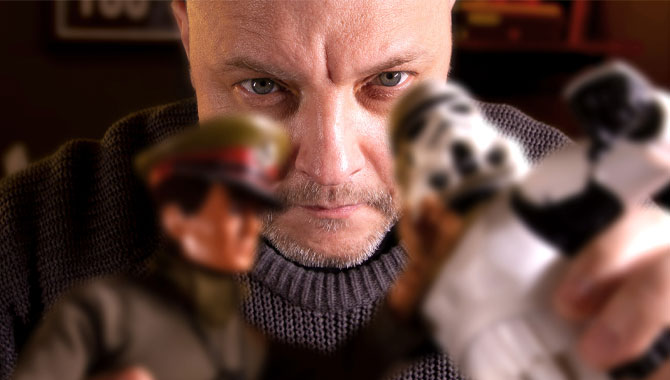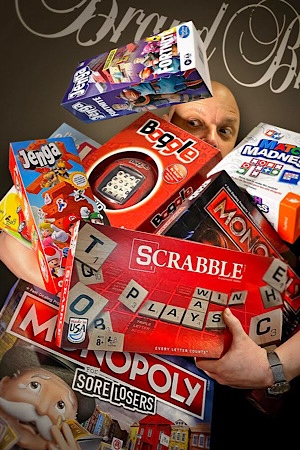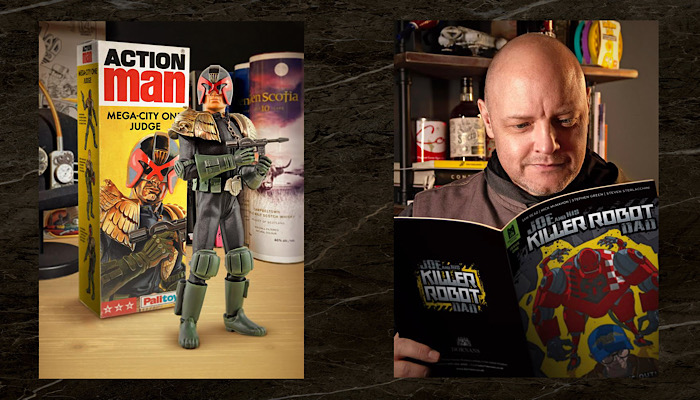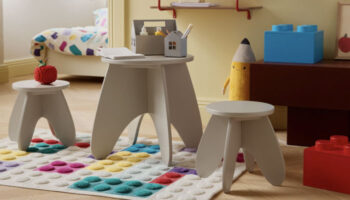Brand Britain’s Steven Sterlacchini discusses toy packaging – and not using process to imitate inspiration

Steve, welcome! We’ve already spoken on our sister site, Brands Untapped… people can read that here. If I introduce you as the co-founder of Brand Britain, how should I describe it?
Brand Britain is a creative graphic design agency, primarily focused on branding and packaging for Toys, Games and Fast Moving Consumer Goods.
You say primarily focused?
Yes, because although branding and packaging are our original core disciplines, we’ve evolved – in more recent years – to meet our client’s growing requirements… Now we find that much of our studio time is utilised creating sizzles, 3D assets, NPD visuals, audits & semiotics, as well as Point of Sale and shopper/marketing resources – now breathe!
Quite the smorgasbord! How did you come to be running your own company, Steve?
After abandoning an early ambition to be a comic-book artist…
Whoa! Don’t gloss over THAT! Why abandon that?!
Ha! Not good enough, or quick enough! So I left Jacob Kramer Art College with the usual pieces of paper, in graphic and advertising design. My age is showing here – this is so long ago that the establishment has changed its name since then…

Anyway, after graduating, I spent a couple of decades gaining invaluable experience at a series of Leeds-based design agencies. They mainly focused on FMCG, but also dallied with web design, during the first boom… Age showing again! I often worked alongside fellow Kramer alumni and eventual Brand Britain co-founder, Russel D’Ambrosio.
And why go into branding and packaging?
Branding – and especially packaging design – has always been a passion, as it can often be the only real touch point between the brand and the customer. The success or failure of a design can be immediately measurable on the retail front line.
Interesting; interesting way to look at it. So… You’re known as Captain Bullet Point for your ability to concisely boil down a client brief! What do you look for, though? What kind of things help you unearth a toy brand’s persona?
You’ve probably nailed it with the word ‘persona’. The best brands make an emotional, personal connection with their audience. If a product is to grow past simple commodity purchase to brand loyalty, it’s usually because the customer – in some way – identifies with the personality of the brand or its owners.

The foundation for toy and game brands is entertainment, but to say ‘keep it fun’ can be an over simplification. It’s more than that. Educate, excite, thrill, frustrate, develop — there are a wide range of emotions and benefits to be communicated. Also, brand personality needs to be consistent across advertising, social media, shopper marketing and packaging. Each media has its own strengths and weaknesses, opportunities and pitfalls.
And to that point, you’re on the record as suggesting you can start work on a project as soon as you understand why a brand or product exists… What’s the best way for companies to identify that with you?
Yes – understanding what’s special about a product or brand forms the foundation for every creative decision. The product and the brand are inextricably linked. So we focus on the basic questions: Why does this exist? What’s unique, new, special, better, or quite simply ‘interesting’ about it? Once we ‘get it’ we become personally – there’s that word again – invested in the brand’s culture.
And is that an easy process?
In most cases, brands will already have an understanding of their USP – and clients will communicate this to us in their initial brief. However, occasionally it can be hidden amongst a plethora of other proposed communications. It simply needs to be focused on and amplified.
When you’re looking to design packaging for toys and games specifically, then, what are the biggest challenges?
The most obvious challenge is balancing disruption and standing out against the customers’ established expectations in what is, generally, a highly creative category. Luckily – on the whole – toys and games are exciting to work on. That makes it easier to find fresh inspiration for each project.
In regards the creativity, then, what’s your process, Steve?
We’re often asked to explain our creative process. We’ve found that there’s sometimes – perhaps understandably – an apprehension towards ‘creativity’. It’s easy for creative people to dismiss this as a lack of trust in the instincts that have been developed and honed through years of experience.

You don’t see it that way?
No, not really. In the early stages of a client and agency relationship, it’s important to build reassurance that any creative decisions are based on sound commercial knowledge or insight. For Brand Britain, ‘the process’ represents a very rough framework. We try to avoid using process to imitate inspiration.
Just expand on that a little for me…
Process can help you get passed the initial blank piece of paper and inform some of the routes explored – but there needs to be more than ticking boxes and rigid obedience to doctrine. Too much adherence to process can result in designs that are formulaic and indistinguishable from each other. In that regard, I’m not surprised by the number of measurably successful designs we’ve created which are substantially different to the initial brief.
That’s fantastic! Part of what you do can help develop the idea beyond the brief. Something else we spoke about before – briefly – was what you call the “squint test”. Tell us a bit more about that…
Right! Well, when you’re immersed in a project, it’s easy to focus on the small details and lose the overall bigger picture. To step away and perform a hypothetical or literal squint test lets us assess if the design will give a good account of itself, in a crowded fixture where the average shopper finds, evaluates, and chooses products in as little as seven seconds – or the e-commerce scroll-by equivalent.
My feeling has always been that you need to grab attention with the front of a game box, sell it with the back… And explain it in the rules! Can you give me a more nuanced view on that?
I think that’s a fair observation, especially in such a visually competitive category. The front of pack is about impact. It’s a chance to stop shoppers in their tracks and make an emotional connection… To do that, it has to be intriguing enough to warrant closer investigation. It’s essential that the back of pack delivers in terms of continuing the initial emotive response, but also communicates the product USPs clearly and – if possible – in an entertaining way.

Like many people in the creative industry, you have your passion projects. Tell me about some of those…
There are obvious commercial benefits to encouraging passion projects, such as the opportunity to improve the company’s skill set and increase our industry knowledge. It can simply be the desire to explore a new process and – rather than waiting for a commercial opportunity – we simply say “what the heck, let’s just do it anyway.”
Can you give me an example of that?
Sure! A good example is the massive learning curve we experienced creating ultra low-budget, science fiction short films. That vastly improved our abilities in live-action direction, storyboarding, digital model making, animation and CGI.
Got it!
I’m also currently working on a new comic book called ‘Joe And His Killer Robot Dad’ and I’ll be honest, I’m doing it primarily because it’s something I’ve always wanted to do, and it’s fun! As a project though, it’s helped me hone new skills which I can apply back in the work studio. For example, it’s already given us a much better understanding of how to build an intellectual property, as well improved our contacts within the pop-culture community.

So the side projects give you skills and insights that come in useful in other areas?
Exactly. I’ve even done side projects simply because they provided an opportunity to create the toy I always wanted as a child, like when I created a one off custom Action Man dressed as Judge Dredd.
Ha!
That was a fun project to work on – and it gave me an opportunity to work with new prototype model makers and illustrators for the first time.
Great answer. And I completely agree, by the way. Let’s wrap this up with my favourite question… What’s the most interesting object in your office on your desk?
Working in the toy and game category does grant you the opportunity to have a desk, or office space loaded with cool stuff. At the moment, the top three cool things adorning my work space are a one-sixth model of a character from the above mentioned comic book project we worked on…
Joe And His Killer Robot Dad?
Yes. This is based on concept designs by the legendary British comicbook artist Mick McMahon… It’s modelled by one of our long-standing digital-3D partners; printed, assembled and painted by a professional prototype maker.

Excellent!
I also have a Nerf Aliens Pulse Rifle. Although we do have a long standing relationship with Hasbro, we weren’t fortunate enough to work on this project. However, that didn’t stop us purchasing one – strictly for the company archives you understand. Finally, I have a 1970’s Skuda LA skateboard in very good condition. It’s the same as a board I had as a child. And yes – unfortunately, I’m one of those middle-aged creatives who skateboards.
Well, could be worse… You could be riding a Pennyfarthing! Thanks for joining us, Steve.
–
To stay in the loop with the latest news, interviews and features from the world of toy and game design, sign up to our weekly newsletter here






















